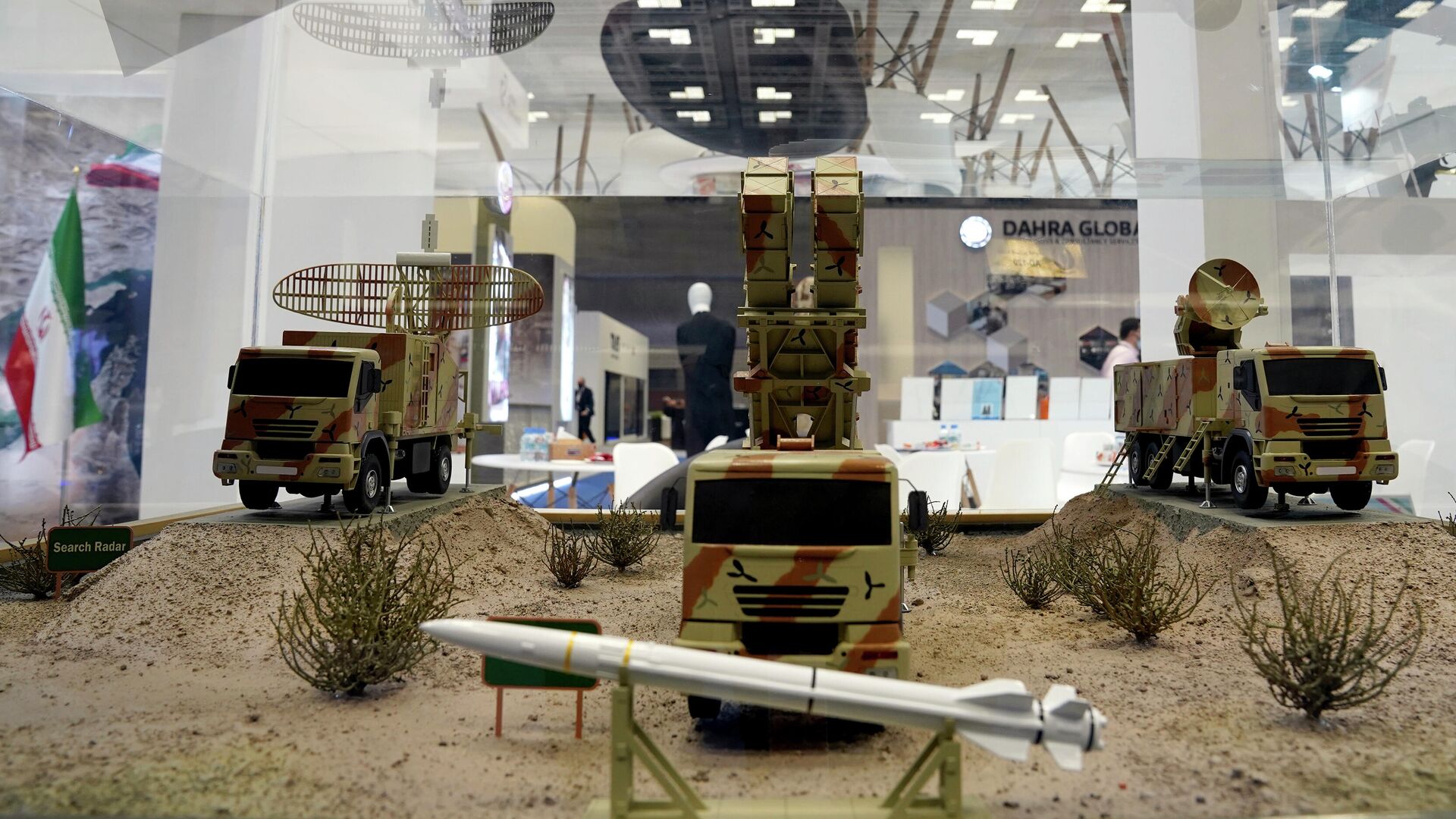https://sputnikglobe.com/20230629/iran-vows-to-further-expand-range-of-its-radar-missiles-drones-1111558626.html
Iran Vows to Further Expand Range of Its Radar, Missiles, Drones
Iran Vows to Further Expand Range of Its Radar, Missiles, Drones
Sputnik International
Iran has amassed an array of thousands of domestically-developed ballistic and cruise missiles in recent decades, sticking to the principle of asymmetrical warfare to try to deter aggression. Earlier this month, the country unveiled its first-ever hypersonic missile – the Fattah.
2023-06-29T19:17+0000
2023-06-29T19:17+0000
2023-06-29T19:25+0000
military
iran
islamic republic
missile
drone
radar
https://cdn1.img.sputnikglobe.com/img/07e6/03/17/1094132014_0:175:3329:2048_1920x0_80_0_0_8293f4b90fec13ba6b266d2e5432b6c1.jpg
Regional security challenges facing Iran make it vital for the Islamic Republic to continue to ramp up the development and production of longer-range radar, drone and missile systems, Iranian Army Air Defense Force commander Alireza Sabahi-Fard has said.“The efficiency of the Army’s Air Defense Force in keeping total control over the airspace over our country testifies to the vigilant observation and monitoring being conducted by air defense specialists at thousands of defense points across the country,” the brigadier general added, saying Iranians can sleep safely at night thanks to the efforts of young specialists working to create a “well-developed” air defense network.Earlier this year, Sabahi-Fard had boasted that Iran’s air defense forces had become an “absolute air defense power in the region,” using 100 percent indigenous, “state-of-the-art” equipment at the forefront of global defense technology.“We are standing on our own feet and do not have any need or dependence on other countries regarding air defense equipment in the areas of detection, identification, engagement, information and communication technology,” he said at the time.Iran has among the densest and most complex air defense networks in the Middle East, with the military taking advantage of the country’s mountainous geography to create a multi-layered crisscross of home-grown long, medium and short-range radar, anti-drone defenses, mobile ground and sea-based missile systems like the Khordad-3 and Bavar-373.Tehran has repeatedly warned the United States and regional adversaries not to test its air defenses, or ability to retaliate to aggression using the vast Iranian missile arsenal.Tensions between Iran and its traditional Saudi rivals dropped dramatically earlier this year after diplomats from the two countries brokered a normalization of relations agreement with China’s assistance. However, tensions between Tehran and Tel Aviv continue to mount as Israeli officials threaten to launch airstrikes against Iran’s nuclear energy sites, citing the Islamic Republic’s alleged pursuit of a nuclear weapon. Iranian officials have long denied having any intention to build nukes, with successive supreme leaders outlawing nuclear arms and all other weapons of mass destruction as an affront to the tenets of Islam.
https://sputnikglobe.com/20230622/iran-plans-to-extend-its-new-hypersonic-missiles-range-1111406844.html
https://sputnikglobe.com/20230427/iran-can-now-track-unique-radar-signature-of-individual-f-35-jets-1109893497.html
iran
islamic republic
Sputnik International
feedback@sputniknews.com
+74956456601
MIA „Rossiya Segodnya“
2023
News
en_EN
Sputnik International
feedback@sputniknews.com
+74956456601
MIA „Rossiya Segodnya“
Sputnik International
feedback@sputniknews.com
+74956456601
MIA „Rossiya Segodnya“
iran, missile, islamic republic, radar, missiles, drones
iran, missile, islamic republic, radar, missiles, drones
Iran Vows to Further Expand Range of Its Radar, Missiles, Drones
19:17 GMT 29.06.2023 (Updated: 19:25 GMT 29.06.2023) Iran has amassed an array of thousands of domestically-developed ballistic and cruise missiles in recent decades, sticking to the principle of asymmetrical warfare to try to deter potential aggression. Earlier this month, the country unveiled its first-ever hypersonic missile – the Fattah.
Regional security challenges facing Iran make it vital for the Islamic Republic to continue to ramp up the development and production of longer-range radar, drone and missile systems, Iranian Army Air Defense Force commander Alireza Sabahi-Fard has said.
“Corresponding to the potential threats and possible challenges we face, the production of advanced long-range radar, missile and drone equipment is most definitely on the agenda of the Army’s Air Defense Force this year,” Sabahi-Fard
said during a surprise visit to an air defense base outside Tehran on Thursday for a snap readiness check.
“The efficiency of the Army’s Air Defense Force in keeping total control over the airspace over our country testifies to the vigilant observation and monitoring being conducted by air defense specialists at thousands of defense points across the country,” the brigadier general added, saying Iranians can sleep safely at night thanks to the efforts of young specialists working to create a “well-developed” air defense network.
Earlier this year, Sabahi-Fard had boasted that Iran’s air defense forces had become an “absolute air defense power in the region,” using 100 percent indigenous, “state-of-the-art” equipment at the forefront of global defense technology.
“We are standing on our own feet and do not have any need or dependence on other countries regarding air defense equipment in the areas of detection, identification, engagement, information and communication technology,” he said at the time.
Iran has among the densest and most complex air defense networks in the Middle East, with the military taking advantage of the country’s mountainous geography to create a multi-layered crisscross of home-grown long, medium and short-range radar, anti-drone defenses, mobile ground and sea-based missile systems like the Khordad-3 and Bavar-373.
Tehran has repeatedly warned the United States and regional adversaries not to test its air defenses, or ability to retaliate to aggression using the vast Iranian missile arsenal.
Tensions between Iran and its traditional Saudi rivals dropped dramatically earlier this year after diplomats from the two countries brokered a normalization of relations agreement with China’s assistance. However, tensions between Tehran and Tel Aviv continue to mount as Israeli officials threaten to launch airstrikes against Iran’s nuclear energy sites, citing the Islamic Republic’s alleged pursuit of a nuclear weapon. Iranian officials have long denied having any intention to build nukes, with successive supreme leaders outlawing nuclear arms and all other weapons of mass destruction as an affront to the tenets of Islam.




